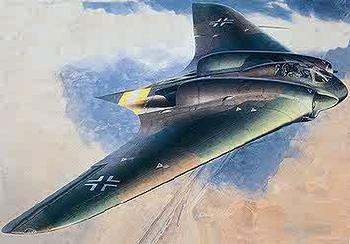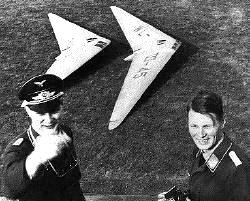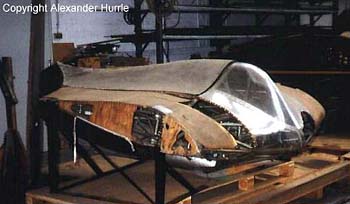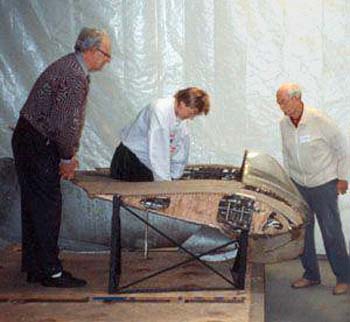
Reimar and Walter Horten
 Horten Ho IX
Model of Go-229 [Ho IX] by Dragon
Almost unknown today, the allwing twin-jet Go 229 was probably the most startling and unconventional warplane built during the WW2. It stemmed from the belief of the brothers Walter and Reimar Horten that a flying wing was the most efficient form of heavier than-air flying machine. They set out to prove this with a series of gliders, beginning with the Horten I of 1931. From 1936 the brothers were officers in the Luftwaffe but continued their work which led in 1942 to studies for a flying wing jet fighter. Accordingly, work was hastened on two prototypes which was all the small team could contemplate. The HO IX V1 was to fly as glider, subsequently being modified to install two BMW 003 A turbojets. Gliding trials at Oranienburg began in about May 1944 and from the start the handling characteristics were outstandingly good. In addition to the V1 and V2, seven more prototypes were ordered plus 20 production fighters. The Go-229 V2 began it's flight test program at Oranienburg in January 1945. Take off required less than 450 m and handling was superb. The programme advanced no further.
Reimar and Walter Hortenby Daniel Ford [copyright 1997, 2000]A precis (cached below) of a longer work "posted on a Usenet newsgroup by John Powell about 1994" and itself part of a larger site also by Daniel Ford
After further experiments, including a motorized sailplane, they built a twin-engined pusher that looked remarkably like the N-1M Flying Wing Jack Northrop would fly in 1940.
The Hortens moved the engines forward and lengthened the propeller shafts, so that their all-wing looked even more like the N-1M. Their Ho 5-B flew successfully in 1938--two years before Northrop's--but was then allowed to languish under the demands of war production. (One of Reimar's projects after the war began was an all-wing transport glider for the invasion of Britain.) Not until August 1941 was Reimar asked to explore the potential of the nurflugel as a fighting aircraft, and even then his work was largely clandestine, in an authorized operation arranged by his brother in the Luftwaffe. In 1942 Reimar built an unpowered prototype with a 61-foot span and the designation Ho 9. After some difficulty the airframe was mated with two Junkers Jumo turbojets of the sort developed for the Messerschmitt Me 262. The turbojet was apparently flown successfully in December 1944, and it eventually achieved a speed of nearly 500 mph (800 km/h). After about two hours of flying time, it was destroyed in a February 1945 crash that killed its test pilot. Its potential was obvious, however, and the Gotha company promptly readied the turbojet for production as a fighter-bomber with the Air Ministry designation Ho 299. (Because Gotha built it, the turbojet is also called the Go 229.) Supposedly it would fly at 997 km/h (623 mph), which if true meant that it was significantly faster than the Me 262--let alone the Flying Wings that Northrop was building. Fortunately for the Allies, the Gotha factory and the Ho 299 prototype--the world's first all-wing turbojet--were captured by U.S. forces in April 1945. Like today's B-2 Stealth bomber (and unlike Jack Northrop's designs), the Go-229 had a comparatively slender airfoil, with the crew and engines housed in dorsal humps, and its jet exhaust was vented onto the top surface of the wing. The first feature made it faster than the stubby Northrop designs; the second made it even harder to detect, as did the fact that wood was extensively used in its construction. One reason that the Ho 229 never got into production was that Reimar Horten was distracted that winter by another urgent project: the Ho 18 Amerika bomber. This huge, six-engined nurflugel was supposed to carry an atomic bomb to New York or Washington, despite the fact that the bomb was mostly theoretical, the engines probably couldn't have lasted the journey, and the plane couldn't possibly have been completed before Germany surrendered. (At 132 feet, its span was a bit less than that of the Boeing B-29 Superfortress, the largest warplane of World War II, but considerably shorter than the Northrop XB-35 that was in the works from 1941 to 1946.) Several nurflugels came to the U.S. as war booty, including the center section of the Ho 229. Four of them are now back in Germany for restoration, with one to remain there when the work is finished, while the other three rejoin the collection of the National Air & Space Museum. A restored Horten sailplane is on display at Planes of Fame in Chino, California, which also owns a Northrop N-9M, a technology demonstrator roughly the size of the Ho 299, but much less sophisticated. The future of the Ho 229 itself is uncertain. The center section is presently at the NASM Garber facility, and will eventually go on display at Dulles, but nobody knows whether it will be finished, or to what standard, or whether it will remain a partial relic. A recent update on the restorations in Germany, as posted by Russ Lee of NASM on the Nurflugel list-serve:
"I visited the Deutschestechnik Museum Berlin last week to check progress on NASM's Horten Ho II, Hoo IIIf, Ho IIIh, and the Ho VI, V2. The H II has been finished for some time but left uncovered prior to exhibition in the new wing of the DTM scheduled to finish in 99 or 00. Enough wing parts and hardware remained to restore/reconstruct the right wing from the Ho IIIf. This work should be finished in a few months. also from Dan Ford's aviation pages
The Development of the All-Wing Aircraft and...
A Flying Wing Bibliography
LinksGERMANY 1930-1945 (excluding Horten - see below)
Luft '46 and...
"Mystery Flying Wing"
HORTEN SPECIFIC
Aerostories : Horten deux frères, une aile.
Horten Nurflügels
Horton Brothers and 'Flying Saucers
HORTEN, AIRCRAFT SPECIFIC
Note 2: As a further backup, the section of the directory related to Horten aircraft was cached to this site on Sept., 23, 2000
Horten IV Restoration
Horten Glider Ho IV
Horten IV, Flying wing
Horten Ho VI
NASM, Silver Hill, restoration by Museum fur Verkher und Technik, Berlin
Horten Ho VI
http://www.das-nurfluegelteam.de/h4_alfons.html
Links Edward Uden. Mitte Frau von Rolf Schmidt. Rechts Heinz Scheidhauer Hortenpilot bis 1945 in Deutschland. Grössenverhältnisse an der Originalmaschine. Heinz Scheidhauer, Testpilot von Raimar Horten, staunt selbst. Herr Scheidhauer flog die meisten Hortenmaschine übrigens liegend !
Gotha Go 229 / Horten Ho IX Flying wing fighter
Wartime notes on the Ho IX
Secret Weapons of the Luftwaffe - The Go 229 [Ho IX]
Comparisons of the Go-229 and Go P-6O Allwing Airplanes
and finally a smaller section on allied wartime and 'just' post wartime development of flying wings, disks etc.
British military prototypes and research aircraft 1946 to date - Tailless Aircraft
Allied X-Planes
Hawker de Havilland D.H.108
|
© Copyright 1999-2004 CTIE - All Rights Reserved - Caution |


